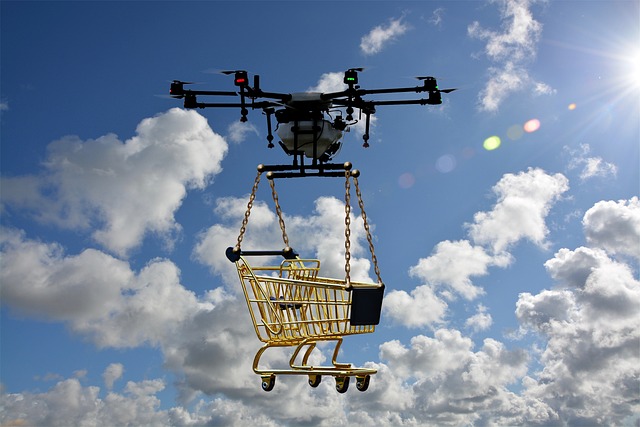In recent years, the evolution of drone technology has been nothing short of remarkable. What was once a military innovation has now become an integral part of various commercial industries. Drones have transitioned from serving primarily military purposes to finding applications in agriculture, healthcare, logistics, and more. In this article, we’ll delve into the fascinating journey of drone technology, tracing its transformation from military to commercial use.
The Military Origins
Drones, also known as Unmanned Aerial Vehicles (UAVs) or Unmanned Aircraft Systems (UAS), initially gained prominence in military operations. In 2022, the worldwide military drone market reached a value of USD 12.55 billion. It is anticipated to expand from USD 14.14 billion in 2023 to USD 35.60 billion by 2030, demonstrating a robust Compound Annual Growth Rate (CAGR) of 14.10% throughout the forecast period.
The concept of remotely controlled aircraft dates back to World War I when both the Allies and Central Powers experimented with early versions of drones. However, it was during the later part of the 20th century that drone technology saw significant advancements.
The Cold War era saw the development of reconnaissance drones used for surveillance and intelligence gathering. These early drones were often bulky and required extensive human intervention. Nevertheless, they laid the foundation for future innovations.
Transition to Commercial Use
The pivotal moment in the transition of drone technology from military to commercial use came with the advent of smaller, more agile drones.
In 2022, the global commercial drone market was valued at approximately USD 19.89 billion. Projections indicate a steady growth trajectory with a compound annual growth rate (CAGR) of 13.9%, expected from 2023 to 2030. This growth can be primarily attributed to the expanding adoption of drones for enterprise applications across diverse industry sectors.
As drone technology continued to improve, these unmanned aircraft became accessible to a broader audience. Here’s how this transformation occurred:
- Miniaturization: Advances in miniaturization allowed for the development of small, lightweight drones that were easier to handle and deploy.
- Cost Reduction: The cost of manufacturing drones decreased significantly, making them more affordable for commercial applications.
- Improved Autonomy: Modern drones are equipped with advanced sensors, GPS systems, and autonomous flight capabilities, reducing the need for constant human intervention.
Commercial Applications
Today, drones have found diverse applications across various industries:
Agriculture: The increasing interest in advanced imaging-equipped agricultural drones is driven by the growing recognition of digital agriculture’s potential. These drones empower farmers by providing the means to oversee plant health, identify diseases or pests, and gauge crop yields through high-resolution aerial imaging. The valuable data gathered enables farmers to take prompt action, ultimately enhancing productivity and the efficient use of resources. This includes precise pesticide application and optimized irrigation strategies.
Agricultural drones further bring advantages such as diminished manual labor requirements, expedited data collection, and extended coverage of expansive farming regions. These benefits translate into cost reductions, heightened efficiency, and increased crop yields.
Healthcare: The healthcare sector is experiencing a robust surge in the demand for unmanned systems, particularly medical drones. Medical professionals within the industry are increasingly recognizing the advantages offered by these drones. Worldwide, nations are establishing the necessary infrastructure and facilities to facilitate the utilization of drones for various medical purposes. Many regions have already implemented these systems to transport vital supplies like food and medicines to remote areas and villages. These factors are expected to accelerate the growth of the medical drone market in the coming years.
The momentum for medical drones gained significant traction during the COVID-19 pandemic as the demand for essential supplies witnessed substantial growth. Medical professionals sought advanced systems that could facilitate the delivery of vaccines, medicines, and food items. These drones also played a pivotal role in collecting pathological and blood samples to expedite virus detection. Notably, countries in Sub-Saharan Africa, including Ghana, Rwanda, and Malawi, emerged as major users of medical drones. Governments in these regions utilized drones to deliver vaccines, medical resources, blood samples, and pathological specimens. Since 2016, they have also employed drones for the transportation of essential commodities like food. These developments significantly bolstered the demand for medical drones during the pandemic.
Logistics: Thanks to the emergence of delivery drones, the prospect of instant deliveries through drone technology is on the verge of becoming a reality. In the past three years, there have been over 660,000 commercial drone deliveries, with 2022 witnessing a remarkable milestone of over 2,000 drone deliveries occurring daily.
Numerous companies have ventured into partnerships with drone manufacturers to explore the potential of instant delivery. Notably, even governments in Europe and Asia have initiated experiments with drone delivery services. However, the common perception still links instant cargo delivery via drones to major players like DHL, UPS, or Amazon. This perception may undergo a significant shift in 2024 as an increasing number of mid-sized companies are scaling up their drone operations. This evolution suggests that drone delivery might cease to be the exclusive domain of multinational logistics giants.
In the quest for swift and cost-effective deliveries, online retailers are harnessing the potential of drones equipped with advanced features such as sensors, cameras, and GPS technology. Despite the remarkable progress made in the drone delivery sector, it faces two formidable challenges: the looming threat of an economic recession and the imperative of sustainability.
Construction and Real Estate: The construction industry’s adoption of drone technology could potentially burgeon into a global market worth $28.3 billion, as projected by PwC. Enterprises operating in these sectors are harnessing drones to streamline compliance with the stringent laws and regulations governing worker safety.
U.S. government regulations mandate that construction firms conduct routine site surveys to guarantee worker safety. Traditionally, this endeavor could consume anywhere from 10 hours to several days. However, with the integration of drone technology, inspections can now be accomplished in a mere 15 minutes, significantly expediting the process.
Challenges and Regulations
The widespread adoption of drone technology has not been without challenges. Privacy concerns, airspace regulations, and the risk of accidents have prompted governments worldwide to establish strict rules for drone operations. Commercial drone operators must navigate these regulations to ensure safe and legal use.
Conclusion
The journey of drone technology, from its military origins to its diverse commercial applications, is a testament to human innovation and adaptability. As technology continues to evolve, drones are set to play an even larger role in shaping industries and improving our everyday lives. The future of drone technology is undoubtedly exciting, with limitless possibilities waiting to be explored.




